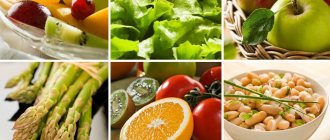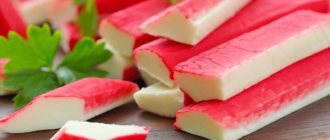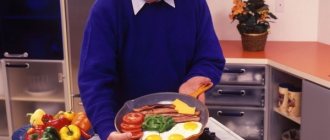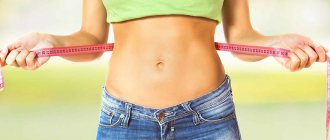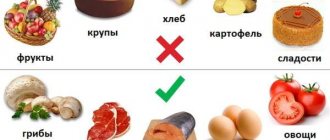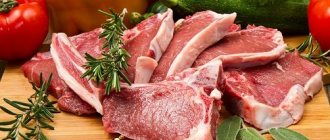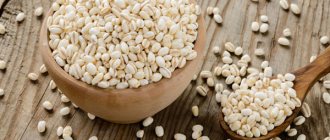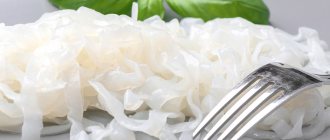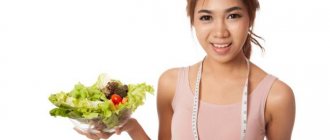The development is based on the principles of separate nutrition. A properly composed menu helps speed up metabolism, improve the functioning of the gastrointestinal tract, improve the immune system and reduce the likelihood of developing an allergic reaction. All this allows you to lose 500 grams of weight daily.
Anna Johansson is a specialist in the field of nutrition, a famous Swedish doctor, and the inventor of the diet. She combined six mono-diets into one complex, which, according to her assurances, will help get rid of 5-8 kg of excess weight. The number of kilograms lost depends on the initial body weight. The duration of the diet is 6 days, each of which consists of a mono-diet diet.
Principles and rules of diet
As with any program, there are principles and rules. Compliance with them is important.
Basic principles:
- The duration of the diet is six days;
- It is necessary to drink water in large quantities;
- To maintain the achieved result, you will have to follow a special regime;
- The basis is separate nutrition;
- Alternation of products.
Each mono-diet included in the complex lasts exactly 24 hours. This regimen, based on alternating protein and carbohydrate days, has long captivated people with its effectiveness. It is strictly forbidden to change your diet regimen on your own. Do not try to switch days of the program. Because the weight loss process depends on the correct alternation of certain foods. Every new day the human body adapts to a certain diet. At the same time, such a schedule helps prevent hunger, which only gets in the way.
Main rules:
- Chew your food thoroughly;
- You can drink water between meals;
- Portions should be frequent and small;
- Completely eliminate sugar, coffee and alcoholic drinks.
The diet does not provoke a deterioration of the condition, but rather improves the functioning of the metabolism, which leads to improved well-being. But at the end of the program, upon returning to a normal diet, a person will gain weight again.
Sixth day. Fruit extravaganza
Good news for coffee lovers: coffee is officially legal today. But: in moderation, without sugar!
Tropical menu
- Breakfast. Salad from your favorite fruits. A cup of freshly ground coffee Second breakfast. Fresh or sweet fruit. 2 apples Lunch. Baked apples with a drop of honey. Fruit puree Afternoon snack. Fresh or sweet fruit. 1 orange. Dinner. Light fruit salad
During the day you can drink fruit juices (freshly squeezed, fresh), tea with lemon and herbal infusions. Remember that fresh juice must be diluted with water by at least one third. Those fruits that ripen in one season are in good harmony. You can prepare a fruit salad with celery.
Useful combinations:
- Apple, ginger – strengthens the immune system.
- Apple, kiwi - beneficial effects on the skin.
- Apple, pear, mango - remove toxins, fight free radicals, normalize blood pressure.
Eat fruit with pleasure! Drink coffee that you brew yourself. The fruits contain enough “fruit sugar” - fructose. The sixth day will fly by.
Mechanism of action
As already mentioned, the essence of the diet is to alternate between protein and carbohydrate days. Skeletal muscles receive sufficient amounts of protein and therefore continue to function normally. Protein prevents the breakdown of muscle tissue, which improves your ability to exercise. Physical activity, in turn, increases energy costs.
A person observes carbohydrate days, but the glucose received is still not enough. The calorie content of the diet is low, which contributes to a deterioration in well-being and decreased performance. To compensate for energy costs, the body begins to consume internal reserves.
First, glucose, useful substances from the blood that come with food, is consumed. Next, the breakdown of liver glycogen begins, which was planned to create new fat cells. At a critical time, when the last reserves are depleted, the body has nothing left to do but destroy fat deposits around the organs and inside the subcutaneous tissue.
Carbohydrate days of the diet contain a diet rich in plant products. Dietary fiber from such food is not completely digested in the small intestine, so passing through it, they cleanse the tract of toxins and harmful substances.
Carbohydrates are simple and complex. The latter are digested slowly, so once they enter the stomach, the fiber begins to absorb liquid. The fibers swell, occupying all available space. Thanks to this, a person feels full for a long time. It turns out that the amount of food consumed is significantly reduced.
Reviews from nutritionists
— This mono-diet will not have time to get boring, because every day there is a new product. But you need to keep in mind that a large amount of protein on a fish, chicken and dairy day can provoke an exacerbation of stomach and kidney diseases, and vegetation will cause indigestion and gas formation. For many diseases, such a diet is prohibited: for example, for diabetes, vitamin deficiency, anemia, problems with the stomach and intestines, and kidney disease, says Dilara Akhmetova, consultant nutritionist and nutrition coach.
Advantages and disadvantages
Advantages:
- Achieving results in a short period of time - six days;
- No need to take additional vitamin complexes and dietary supplements;
- Food products are freely available;
- Balanced, varied diet;
- Fast cooking;
- Lack of hunger;
- Possibility to independently create a menu for the day;
- Cleansing the body of harmful substances;
- Thanks to a varied diet, your mood improves;
Flaws:
- The daily diet consists of foods of one type;
- Dieting is difficult for people who work in an office;
- There is a possibility of developing headaches, nausea, and dizziness on protein days.
Volume of food servings for each day of the week
The amount of food consumed daily must be regulated, otherwise the result may not be achieved.
- on fish it is allowed to consume up to 500 g per day.
- on a vegetable one you can eat three times as much (1500 g).
- like on a fish day, a chicken day assumes a daily allowance of no more than half a kilogram.
- at the cereal stage, the serving volume can be found based on 250–300 g of dry product (in total, a glass of unprocessed cereals is obtained, but cereals naturally increase in volume when boiled or other heat treatment).
- A curd day involves consuming no more than 500 g of product.
- the fruit feast is limited to one and a half kilograms.
Try to distribute the daily amount of food into 4-5 equal portions, taking into account a reserve of 3 hours before bedtime.
Contraindications
It is better to coordinate the choice of any dietary program with a nutritionist. Only he will help you choose the right diet that is right for you. And before you start choosing, you should pay attention to the existing contraindications.
These include:
- Diseases of the digestive tract;
- Diseases of the cardiovascular system;
- Bone marrow pathologies;
- Immunodeficiencies;
- Diseases of an infectious or viral nature;
- Age up to 18 and after 60 years;
- Endocrine system disorders;
- Pregnancy period;
- Breast-feeding;
- Kidney diseases;
- Liver pathologies;
- Inflammatory processes;
- Psychological deviations.
Dietitian about weight retention after diet video
Top 7 best drugs for weight loss
| Name | Price |
| Black Latte for weight loss | 99 rub. |
| NATURAL Fit Calorie Blocker Powder | 990 rub. |
| Purple tea "Chang-Shu" | 499 rub. |
| Fat burning drops “Honey Spas” | 1980 rub. 99 rub. (until 08/24/2021) |
| Detox cocktail for weight loss | 147 rub. |
| Lipocarnit for weight loss | 990 rub. |
| Reduslim weight loss product | 149 rub. |
Views: 9,774
Six petals diet menu (Eating routine)
The diet of each new day of the diet consists of new foods. You will have to alternate different menus for six days. A detailed diet can be compiled based on personal taste preferences. The main thing is that you will have to give up frying dishes during the cooking process, as well as adding spices and salt.
A properly selected diet will be balanced in all respects, which will lead to a decrease in body weight, as well as a decrease in volume.
A six day diet might look like this.
The first day. Fish mono-diet
Fish meat contains a large amount of polysaturated acids. They enrich the body with omega-3s, which are healthy fats. Due to them, fat reserves are destroyed, as well as cholesterol levels in the blood decrease. Therefore, there is a strengthening of the heart muscle, reducing the risk of heart attack, stroke, and atherosclerosis. There is a noticeable improvement in metabolism. Fish protein is easily digested and absorbed by the body, suppressing the feeling of hunger. Its content reaches 25%. Amino acids are easily absorbed by the body in 2-2.5 hours.
Sample fish day menu:
- First breakfast. Boiled fish with the addition of a small amount of spices.
- Lunch. Fish cooked in the oven. You can add greens to improve the taste.
- Dinner. Ukha without adding vegetables.
- Afternoon snack. Steamed fish. You can use some spices.
- Dinner. Stewed fish.
Between main meals you are allowed to drink an unlimited amount of fish broth and green tea.
The main dietary products are pike and cod. Salmon, trout, and pink salmon will speed up metabolism due to their high levels of fatty acids. Therefore, you can safely use them.
Frozen fish is an excellent option for safety reasons. But such meat contains fewer nutrients due to heat treatment. Buy fresh fish only from trusted people.
Second day. Vegetable mono-diet
On a vegetable day, the body receives large quantities of plant fiber, which helps to increase the feeling of satiety and cleanse the body of waste and toxins. Plant carbohydrates are digested slowly, so the body has to use its own energy reserves for this. Thus, fat burning occurs.
Vegetable dishes can be baked or steamed. An excellent option would be to prepare a popular drink today - a smoothie.
Sample vegetable day menu:
- First breakfast. Carrot and cabbage salad.
- Lunch. The vinaigrette.
- Dinner. Stewed vegetable stew with a little salt.
- Afternoon snack. Whole steamed vegetables.
- Dinner. Ratatouille with a little salt and spices.
Between main meals, you are allowed to drink unlimited quantities of fresh vegetable juice and unsweetened tea.
Day three. Chicken mono diet
The composition of lean chicken meat contains a large amount of amino acids and nutrients. Chicken protein will not turn into fat deposits, so the body has to spend its own reserves to restore anergy.
Sample chicken day menu:
- First breakfast. Chicken fillet, boiled without skin. You can add a little salt.
- Lunch. Chicken fillet can be baked in a baking oven with a small amount of spices.
- Dinner. Chicken soup, to which you can add a little seasoning.
- Afternoon snack. Chicken fillet cooked on the grill.
- Dinner. Chicken meat, steamed with a little salt.
To drink chicken broth between meals, you need to strain it. You are also allowed to drink unsweetened tea unlimitedly.
Day four. Cereal mono-diet
The fourth day of the diet involves eating cereals that have not been husked. You can safely eat whole grain bread. The best way to prepare porridge is steaming, thanks to which the cereal will not lose nutrients and is better absorbed by the human body.
Sample cereal day menu:
- First breakfast. Steam sprouted wheat grains with water and prepare porridge.
- Lunch. Green buckwheat, cooked as porridge with a little salt.
- Dinner. Brown rice boiled in water.
- Afternoon snack. Oatmeal porridge, pre-soaked overnight.
- Dinner. Barley porridge, slightly salted.
On a cereal day, you can drink a little natural kvass and unlimited quantities of unsweetened tea.
Day five. Curd mono-diet
Cottage cheese will help replenish calcium reserves in the human body. The amino acids included in its composition contribute to the restoration and renewal of cellular structures. It is better to give preference to natural cottage cheese with a low fat content.
Sample menu for curd day:
- First breakfast: low-fat cottage cheese with a small addition of natural yogurt.
- Second breakfast: grainy cottage cheese.
- Lunch: a combination of low-fat cottage cheese and milk.
- Afternoon snack: casserole;
- Dinner: low-fat cottage cheese without additives.
Between main meals, milk, kefir and unsweetened teas are allowed.
Day six. Fruit mono-diet
Finally, the body will be replenished with energy due to the intake of complex carbohydrates, as well as polysaccharides from fruits. In addition, they contain pectin, vitamins, enzymes, and amino acids. In addition to them, a large amount of organic substances and antioxidants are supplied. Fruits are a storehouse of nutrients that the body needs when following a diet. Due to their taste, they are much more pleasant to eat than vegetables. But, given their possible calorie content, you will have to carefully select ingredients for nutrition.
Sample fruit day menu:
- First breakfast: a combination of apples of different varieties;
- Second breakfast: large banana.
- Lunch: a variety of citrus fruits.
- Afternoon snack: pomelo.
- Dinner: a combination of kiwi and pineapple.
You can treat yourself to fresh fruit and tea.
Second day. Vegetables
Any vegetables are allowed.
Pumpkin, turnips, Brussels sprouts, green beans, turnips, some potatoes, carrots, beets, bell peppers, broccoli, zucchini, cucumbers...
We will make your vegetable day bright. Each vegetable has its own taste, with a specific note: bitterness, sourness, it can be tart or sweetish, with an enveloping softness.
Vitamin menu
- Breakfast. Salad (carrots, beets, turnips, Jerusalem artichoke) Second breakfast. Baked vegetables with herbs Lunch. Vegetable stew with sweet pepper Afternoon snack. Light tomato soup Dinner. Steamed vegetables with herbs
Limit the addition of oil and salt. Avoid hot spices, because... they whet the appetite and awaken the taste buds. We don't need this today.
Preference should be given to fresh vegetables, they contain more vitamins. Use smoothies and fresh juices with caution, they have a specific effect. Feel free to eat stewed, boiled, steamed vegetables, stews and salads with the addition of herbs without oil. Dishes from turnips, pumpkins, artichokes, which are undeservedly forgotten, will allow you to discover new shades of taste. You can combine vegetables with herbs and a small amount of spices. It's vitamin day!
Unexpected combinations
- Cook cauliflower with basil, dill, curry, nutmeg, oregano, coriander or mint. Cumin, tarragon, and parsley are suitable. Spices go great with this vegetable.
- TRY turnip recipes. Suitable baked with thyme or steamed.
- Healthy fresh juice is obtained from cucumber and cabbage. A cucumber consists almost entirely of water and such freshly squeezed juice does not need to be diluted. White cabbage juice is recommended even for people with gastritis.
Authorized Products
Each day of the diet should consist exclusively of foods prescribed by the program.
On fish day, you can eat different types of fish and seafood. You can cook fish in any way that meets the diet criteria. You will have to give up fish fried in oil. A grill, oven or steamer works great. In order not to contribute to the retention of excess fluid in the body, it is better to use salt in minimal quantities. It is allowed to use a little seasoning for taste.
The second day is a vegetable day. Here you can eat vegetables: raw, stewed and boiled. You are even allowed to eat potatoes here, albeit in small quantities. The dish can be seasoned with vegetable oil, salt and seasonings can be added. Vegetable smoothies will help diversify your diet.
On the third day, it is strictly forbidden to eat anything other than chicken. Give preference to chicken fillet. Be sure to remove the skin before cooking. The methods for preparing poultry are the same as for fish.
Cereal day involves cooking porridges mainly from cereals with preserved shells. A person on a diet can drink some natural kvass, eat rye or whole grain bread and sprouted grains. Keep salt and seasonings to a minimum. It is advisable to soak the cereal overnight before preparing porridge.
The fifth day is the use of low-fat natural cottage cheese without any additives. You are allowed to drink a small amount of low-fat kefir, milk and natural yogurt.
The last day is fruits, which can be eaten raw and baked. You can prepare fresh fruit juices and compotes with a small addition of vanillin.
Be sure to follow the drinking regime. Drink at least 1.5 liters of water per day. You are allowed to drink a cup of coffee once a day. Drink unlimited amounts of green and black tea without sugar.
Day four. Cereals
It's cereal time! We take the next portion of nutrients. The cereal diet unloads after a protein day and prepares for the curd and milk mono-diet.
Menu The Power of Cereals
- Breakfast. Hercules on the water is not thick. Second breakfast. Sprouted wheat, greens Lunch. Multikasha 4 cereals Afternoon snack. Bran bread. Greens sprinkled with lemon juice Dinner. Buckwheat steamed in water
Porridge with water, without oil. Buckwheat, rice, oatmeal. Barley and wheat porridge are very useful. Add a small amount of herbs and spices if desired. You can include wheat germ in your diet with caution (if you have never taken it before). This is a storehouse of useful substances. Diversify your diet with grain breads and bran. Kvass (homemade) is allowed. It's better to create this delicious drink yourself.
To have a good fourth day, you need to prepare in advance. For example, take care of creating homemade kvass. Sprout grains and evaluate their effect on your body.
Experiment with water-based porridges, of which there are a huge variety. Do not use “porridge from bags”; rinse the cereal thoroughly, which has a good effect on the quality of cooking. You will learn a lot of new things and track your body’s reaction.
Prohibited Products
The list of prohibited foods depends on the day of the diet. For example, on a vegetable day you should not eat fish or chicken, and vice versa.
But you will have to completely abandon the following products:
- Sugar;
- Baking;
- Fast food;
- Pasta;
- Fat;
- Smoked;
- Sausages;
- Canned food;
- Artificial sauces;
- Oil;
- Margarine;
- Carbonated drinks and store-bought juices;
- Alcohol.
Day five. Cottage cheese, dairy products
- Low-fat cottage cheese (2-3%) Milk Kefir, low-fat fermented baked milk Yogurt without additives, with a short shelf life
You can make your own yogurt.
Menu Calcium-plus
- Breakfast. Cottage cheese 3-5%. Natural yogurt Second breakfast. Glass of milk Lunch. Homemade cheese with herbs or cottage cheese 3-5% Afternoon snack. Kefir. Low-fat cottage cheese Dinner. Natural yogurt or milk
Low-fat varieties of cheeses, soft or hard, are possible. Varieties with a sharp, salty taste are not suitable. Be mindful of calories.
Whether to include cheese in your diet depends on the expected result. The cheese contains milk and cottage cheese. You can make your own cheese. You will be 100% sure of its calorie content. Use low-fat ingredients. Add a little salt and spices.
If you don't drink milk
- Kefir, fermented baked milk. You can remember about whey.
Dairy products with low fat content and a short shelf life are suitable for curd day. Try combining them. Track your reaction. Make your menu in advance!
Recipes for the 6 petal diet
Use your imagination and experiment with preparing a variety of dishes.
Baked pollock
Ingredients:
- Pollock;
- Greenery;
- Salt.
The fish must be cleaned, gutted and washed thoroughly under running water. If you like greens, put them inside the carcass. You can add a little salt. Cooking method: bake in the oven until golden brown.
Peppers stuffed with vegetables
A fairly common dish in everyday life is stuffed peppers. It can be prepared for your dietary needs.
Ingredients:
- Several pieces of pepper;
- Onion;
- Tomatoes;
- Carrot;
- Zucchini;
- Garlic.
Cut the tomato into thin slices and grate the carrots on a coarse grater. Next you need to finely chop the onion and garlic. All ingredients must be placed in a frying pan to simmer for ten minutes. After cutting the zucchini into small pieces, add them to the vegetable mixture. After receiving the minced vegetables, peel the peppers and fill them with filling. You can use a slow cooker for cooking.
Chicken in its own juice
There are a lot of recipes for cooking chicken. Here is one of the interesting options.
Ingredients:
- Chicken fillet;
- Greenery;
- Salt.
Rinse the chicken fillet thoroughly under running water, seasoning with a small amount of salt and herbs. For cooking, you must use dishes with a thick bottom. A saucepan works great. Place the chicken in it and close the lid tightly. Simmer the meat over low heat for about three hours. No need to add water or oil. A completely closed lid allows the meat to release its own juices.
Buckwheat cutlets
Ingredients:
- Buckwheat grain;
- Greenery;
- Salt.
To prepare such cutlets you need to use steamed buckwheat. Pour salted hot water over the cereal about an hour before cooking. Place the buckwheat and herbs in a blender bowl, grinding until smooth. Lightly wet your hands and shape into desired size patties. To prepare, place the resulting cutlets in the oven for 20 minutes.
Curd cheesecakes
Ingredients:
- Cottage cheese;
- Semolina;
- Egg.
Mash the cottage cheese with a fork, mixing it with the chicken egg. Form the mixture into balls of the required size, roll in semolina and bake until crust forms.
Green smoothie
Smoothies have gained popularity recently.
Ingredients:
- Kiwi;
- Banana;
- Apple juice.
Cut the fruit into small pieces, place them in a blender bowl and blend until smooth. Instead of banana and kiwi, you can use any combination of fruits.
Meatballs from white fish species
Ingredients:
- White fish fillet;
- Greenery;
- Salt.
Among white fish, you can choose pollock. Make minced meat from its fillet, to which you can add any greens to taste. With a little salt, form small meatballs. Cooking method: bake in the oven until done.
Eggplants stewed with tomatoes
Ingredients:
- Eggplant;
- Tomatoes;
- Garlic;
- Salt.
Cut a large eggplant into pieces, salt it and place in a colander. After half an hour, rinse thoroughly and dry the vegetable cubes well. Using a non-stick frying pan, simmer the tomatoes and eggplant for twenty minutes. Depending on your taste preferences, you can add a little garlic and salt.
Vegetable soup
Ingredients:
- Carrot;
- Bulb;
- Eggplant;
- Tomatoes;
- Garlic;
- Salt;
- Seasonings.
Chop the vegetables as finely as possible. Place the pan on the fire and add the ingredients one by one after the water boils. The cooking process reaches twenty minutes. At the end, you can add your favorite spices and salt in small quantities.
Vegetable cabbage rolls
Ingredients:
- Cabbage;
- Zucchini;
- Carrot;
- Bell pepper;
- Tomatoes;
- Bulb;
- Salt;
- Soy sauce.
Remove the stalk from the cabbage and boil until the leaves are soft. Next, start preparing the filling: cut all the vegetables into thin strips, simmer for ten minutes in a frying pan. Season the resulting mixture with a small amount of soy sauce. Place the prepared filling inside the cabbage leaves. Place the resulting cabbage roll on a baking sheet and bake. For the gravy, fry the onion with grated tomatoes in water.
Cheese and curd dumplings with milk soup
Ingredients:
- Cottage cheese;
- egg white;
- Cheese;
- Milk.
Mix cottage cheese with egg white, whipped to soft peaks. Melt the cheese to a thick porridge in a water bath. Form a ball from the resulting mixture and place the cottage cheese in the center. Put the milk on the fire, and after boiling, lower the curd dumplings.
Cottage cheese casserole
Ingredients:
- Cottage cheese;
- Egg;
- Semolina;
- Raisin;
- Low-fat sour cream.
All listed components must be mixed using a blender until smooth. Pour the resulting mixture into any silicone mold and bake until done.
Yogurt-chocolate dessert
From time to time you can treat yourself to desserts.
Ingredients:
- Milk;
- Natural yogurt;
- Cottage cheese;
- Cocoa;
- Coffee;
- Vanillin.
Beat the ingredients with a blender and freeze using silicone molds.
Curd soufflé
Ingredients:
- Cottage cheese;
- Cinnamon;
- Natural yogurt;
- Stevia;
- Agar-agar.
The components must be combined and blended until smooth with a blender. Agar-agar can be replaced with powdered gelatin, previously soaked in water.
Cottage cheese pudding
Ingredients:
- Cottage cheese;
- Semolina;
- Milk;
- Raisin;
- Dried apricots.
Prepare everyone's favorite semolina porridge without lumps. After cooling, mix it with cottage cheese and dried fruits. After whisking well, add the egg white. Pour the resulting mixture into a silicone mold. Bake at low degrees for about 20-30 minutes.
Rules, recommendations, tips for following a mono-diet
During the diet, you need to follow the rules recommended by nutritionist Anna Johansson. In addition to the unchanged order of days of the mono-diet, you need to remove the following foods from your diet:
- bread,
- sugar,
- chocolate,
- preservatives,
- oil.
Observe the following rules:
- monitor the freshness and quality of products,
- drink plenty of fluids (green tea, clean water),
- limit coffee consumption,
- do not use sweetener,
- completely eliminate alcohol,
- liquid can be drunk no earlier than 30 minutes after eating,
- do not eat 3 hours before bedtime,
- reduce the amount of spices and salt.
Quitting the diet
Having put in a lot of effort, everyone will want to keep the result for a long time. To achieve this you will have to adhere to certain rules for some time:
- For several days after finishing the diet, follow the prescribed diet;
- Practice separate meals for a while. To gradually return to your normal diet, you need to gradually add non-dietary foods to your diet meals;
- Gradually increase your daily calorie intake;
- Choose foods carefully, because during the diet the body has become accustomed to a gentle diet;
- Engage in physical exercises that will help maintain the results obtained, improve the tone of muscle fibers and prevent sagging skin.
You can follow a six-day diet course no more than once a month, and a two-week program can be used no more than four times a year.
The correct exit from a dietary course is the basis for long-term preservation of results.
Recommendations
Nutritionists consider the Swedish weight loss system to be very effective, since it implements the principle of separate nutrition, which is effective for weight loss. To achieve maximum results, follow these tips and tricks:
- eat in small portions;
- drink plenty of fluids;
- do fitness;
- do not start the process of losing weight if you have just been ill and your body is weakened;
- choose fresh food, do not cook for future use;
- although salt and spices are not prohibited, try to minimize their amount, as they stimulate appetite and retain fluid in the body;
- When losing weight, do not drink alcohol, as it also contains calories and, moreover, stimulates appetite.
How long can you go on a diet?
The creators of the diet promise that by following the 6 petals program, you can lose from 5 to 7 extra pounds. This diet is ideal for emergency weight loss. Therefore, observing it more than once every six months is dangerous for health. The entire program is designed for six days, the seventh is a fasting day, when you can only drink water.
If it was not possible to achieve the desired result, you can repeat the program. But, it is advisable to take a break for about two weeks. This or the previous “yellow” is incorrect. To consolidate the results obtained, it is better to alternate protein and carbohydrate days from time to time. You can achieve maximum weight loss if you add physical activity, such as walking, yoga, cycling, and morning exercises.
Day three. White chicken meat
It is recommended to use breast or fillet, chicken broth.
The good news is that “chicken day” is much easier to tolerate than fish, which is unusual for many, which is confirmed by reviews of the 6 petals diet! This is a protein day, we are saturated with healthy protein, necessary for every cell.
Menu Meat-light
- Breakfast. Cold chicken breast with cilantro and celery Second breakfast. Steamed chicken breast Lunch. Breast broth with herbs Afternoon snack. Chicken fillet baked in foil Dinner. Chilled fillet with herbs
Try to prepare the meat thoroughly. It is recommended to soak chicken breast in water for 2-3 hours. You can use mineral water. The chicken becomes many times softer and juicier. This is delicious. Many restaurateurs advise, after draining the first broth, to cook the chicken until done “on the second”.
This day is rich in protein, an important element for cellular structure. White meat contains iron, vitamins B, H, PP, A, E, D, minerals Na, K, Mg.
Real reviews about the “6 petals” diet
Having studied thematic forums about weight loss, you can find positive and negative ratings from users. When reading reviews, pay attention to the presence of supporting photographs.
Eating in mono mode helps the body burn old fat reserves. When combined with physical training, the results are often truly positive. However, it is worth remembering that the kilograms go away quickly - but, as we remember, they will soon come back, just like after any other diet.
Here are some real reviews from the Internet:
- — Is it necessary to constantly measure volumes and centimeters?
- - Not always. In some cases, women measure parameters before the diet and at the end of the course.
- — What determines the number of kilograms lost?
- — Of particular importance is the person’s initial weight, as well as adherence to diet and physical training.
- — How much time should you devote to physical exercise every day?
- — It’s enough to practice hoops 20 minutes a day.
- — How quickly do lost kilograms come back?
- — It all depends on the individual characteristics of the body. For some, the weight will return in a week, for others it will last a month, maybe even more. The correct exit from the diet is of certain importance.
- — Is the diet program easy for everyone?
- - Definitely not.
- — How can you further promote weight loss?
- — Make it a habit to regularly hold fasting days, which allow you to cleanse your body of waste and toxins.
The petal diet is a great way to lose weight without harming the body. Relatively quickly, almost comfortably, but - alas, not for long. The game part of the diet instructs a person to draw a flower, each petal of which represents one day. Having overcome a new day, tear off a petal. The issue of weight loss for many female representatives is quite acute. Therefore, the diet program is gaining popularity.
Basic principles
The 6 petals mono-diet was developed by a professional nutritionist from Sweden, Anna Johansson, and it is based not on popular stereotypes, but on specialized knowledge regarding the structure of the human body, chemistry, biochemistry, and so on. In addition, the author of the diet does not hide the principles of its work and explains why this regime allows you to quickly get rid of extra pounds. In short, the diet is based on the principle of separate nutrition. And the game element that gave the diet its name helps you not to break down. Draw a beautiful flower with six petals, each of which will correspond to one of the days of the diet. At the end of each day, tear off a petal, thus getting closer to your cherished goal.
The essence of the 6 petals diet can be boiled down to the following basic characteristics:
- The basic duration is six days. If desired, you can repeat another cycle starting from the first day.
- Includes six one-day mono-diets.
- In six days you can get rid of several extra pounds.
- The creator recommends repeating the diet 1-2 times a year.
- By following this diet, we do not lose muscle mass. Only the fat goes away.
- You cannot adhere to the diet during pregnancy and lactation, or if you are allergic to its components. If you have gastrointestinal diseases, you should first consult with a specialist.
The 6 petals diet of Anna Johansson, as already mentioned, consists of six mono-diets that follow each other in a clear order: proteins alternate with carbohydrates. The nutritionist claims that this is what forces the body to actively burn fat deposits.
The “petals” cannot be swapped. First comes a fish diet, then a vegetable diet, then chicken, cereal, cottage cheese and fruit. Each diet lasts exactly one day. The seventh day may be the beginning of a repeat cycle or, on the contrary, an opportunity to relax. And some people prefer to go on a hunger strike on this day, thereby securing their weight loss results.
The author of the diet claims that it will be effective for absolutely every person, regardless of his individual characteristics, since its effectiveness is based on the general physiology of digestion. Every day you will eat the same type of food, thereby avoiding harmful and difficult combinations. This alone contributes to the effective fight against excess weight.
Anna Johansson also insists that short-term, low-calorie mono-diets are an effective way to lose weight. Moreover, just one day is the optimal duration for them. When the body feels stressed, it draws energy from fat deposits. And this is exactly what we need. If a mono-diet is long-term, it loses its effectiveness as the body adapts to it.
Nutritionist Anna Johansson reports that the body begins to lose fat by the middle of the first day of the diet. Thus, in one day we lose 0.5-1 kg, which is a pretty good result. But it is very important not to change the sequence of mono-petal diets. Only the sequence proposed by the Swedish specialist allows the body to eliminate fat reserves without suffering from energy starvation.
Expert's conclusion
It would seem that we can only rejoice and start recommending this next “miracle way to lose weight” to everyone. But we know too well that, firstly, any diet must be prescribed by a specialist, taking into account the individual data of each patient; and, secondly, that weight loss as a result of any diets is not for long. Temporarily. Even for a short time. This is because physical dietary restrictions can only be a means of losing weight, but cannot be a means of keeping it normal.
To summarize all of the above, let us recall the old wisdom of professional fighters against obesity: “excess weight is in the head.” No diet changes the patient’s eating habits, does not form the right attitude towards food and cannot last forever. This means that soon after leaving it, a person will be doomed to look for more and more new ways to get rid of the extra pounds that are gaining. Lucky are those who meet a weight loss psychotherapist on their difficult path. For it is psychotherapeutic techniques that bring the patient, exhausted by diets and hunger strikes, the long-awaited stability of weight loss results, health, beauty and confidence in the future. This is a fact of life, confirmed by statistics.
Expected results
Based on the principle of separate nutrition, the 6-petal diet promotes the proper functioning of the digestive organs, in which they do not accumulate excess fat. A monotonous daily diet ensures rapid weight loss and leaves no chance for extra pounds.
If you strictly follow all the recommendations of the creator of the diet, then per day of the diet you will lose 500-800 grams of weight. Thus, in all 6 days, up to five kilograms can be lost, depending on the initial weight. After a certain time, if desired, the six-day diet can be repeated.
Psychological component
To achieve maximum results with minimal losses, the Scandinavian nutritionist decided to use the moment of play in her methodology. The days you plan to spend on a diet, draw on paper in the shape of a flower with six petals, cut out the flower and fix it on the wall or refrigerator. Each petal will correspond to a specific day of your diet. The day was over - the petal was torn off. Six days - six petals. Such improvisation and visibility have a very positive effect on mood. Both understandable and fun!
Basic rules
The “6 petals” diet is based on the following principles:
- The sequence of mono-diets cannot be changed. The process of weight loss depends on their correct alternation.
- Meals should be made in fractions (4-5 times a day).
- Within 24 hours, you should eat meals made from only 1 recommended product, and chew the food thoroughly.
- It is necessary to drink plenty of fluids, but do not drink liquids during meals.
- You should completely avoid sugar and products containing it.
You can cook food in any way except frying in oil. Doing physical exercise helps to consolidate the results achieved.
Authorized Products
The menu of each day of the petal diet should include only those types of food that correspond to it.
List of permitted products:
- Fish of any kind, but prepared in dietary ways: boiling, baking, stewing, grilling or steaming. The amount of salt is limited.
- All vegetables, incl. and starchy foods (for example, potatoes) in boiled, stewed, baked form. Preference is given to salads made from fresh ingredients, to which you can add herbs, a little vegetable oil and salt.
- Skinless chicken prepared using the same principles as fish. The amount of seasonings and salt is minimal.
- Cereals - mainly with a pityriasis shell, bread - only whole grain. The consumption of sprouted grains and a small amount of bread kvass is allowed.
- Natural cottage cheese with an average percentage of fat content. Those who do not like this product are allowed to replace it with soft cheeses (for example, mozzarella and Adyghe) or tofu cheese.
- During the day you can drink 1-2 tbsp. low-fat kefir/milk.
- Fresh fruits are consumed raw, baked and steamed; salads, fresh juices, and compotes are prepared from them. Cinnamon and vanilla are allowed as seasonings.
The drinking regime involves drinking about 1.5 liters of clean still water per day. As additional drinks, you can drink black and green unsweetened tea without strict restrictions, coffee without sugar - no more than 1 time a day.
Fully or partially limited products
While following this diet you should not consume:
- pastries and bread;
- all types of meat, except chicken;
- sugar and any sweets;
- semi-finished products and fast food;
- canned food and sausages;
- saltiness and smokedness;
- butter and margarine;
- high fat dairy products;
- ready-made curd masses (contain synthetic flavors and flavoring additives);
- mushrooms;
- dumplings, dumplings, ravioli;
- chocolate and nuts;
- pasta;
- alcoholic and carbonated drinks.
The list of prohibited foods also includes all types of food that do not correspond to the daily dietary intake.
